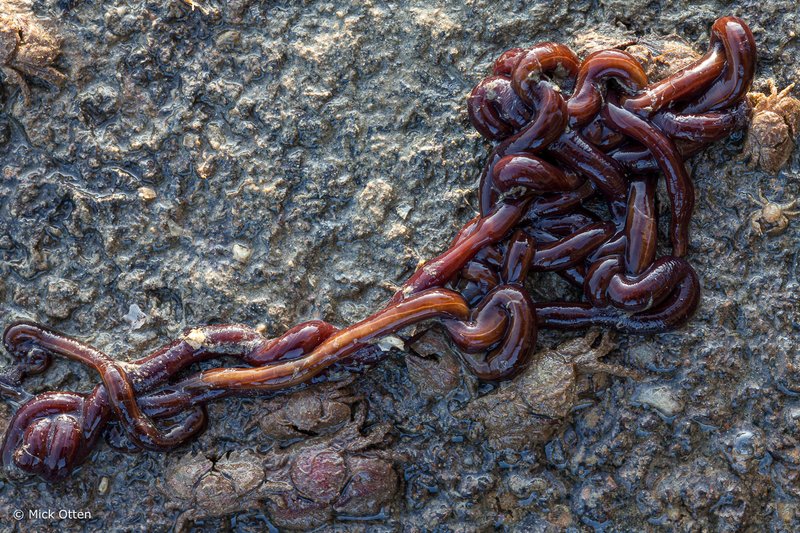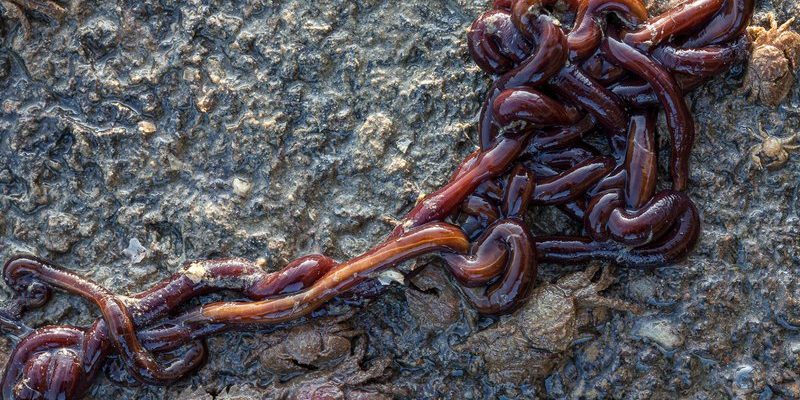
Bootlace worms might not be on your radar, but these fascinating creatures, known as *Lineus torquatus*, can be found in various environments. They leave behind a distinct, slippery mucus trail which glows under UV light, making it easier for us to see where they’ve been. So, grab your UV flashlight, and let’s explore this captivating method of tracking bootlace worms and the places they roam!
What Are Bootlace Worms?
Bootlace worms are intriguing marine creatures that can grow quite long—some reaching lengths up to 30 meters! They have a soft, elongated body that resembles a bootlace, hence the name. While they might look like a simple piece of seaweed or a long strand of spaghetti, they play an essential role in their ecosystem.
These worms are mostly found in sandy or muddy areas and can be spotted in intertidal zones. They’re pretty shy and tend to burrow into the substrate, which makes them a bit of a mystery. So, how do we find them? That’s where the magic of UV light comes into play!
How Do UV Lights Work?
You might be wondering what UV light really is. Essentially, it’s a type of light that is invisible to our eyes but can reveal things we can’t normally see. Think of it as a special pair of glasses that only shows certain information. UV light has shorter wavelengths than visible light, which gives it the power to expose hidden features in materials, such as the flashy trails left by bootlace worms.
When you shine a UV light on certain surfaces, some materials absorb that light and re-emit it at a different wavelength, creating a soft glow. This principle is what allows us to find bootlace worm mucus trails. The mucus has specific compounds that fluoresce, making it pop when hit by UV rays. It’s like turning on a black light at a party—you see all the fun details that you might have missed otherwise!
Choosing the Right UV Light
When it comes to using UV light for this purpose, not all UV lights are created equal. You’ll want to select a handheld UV flashlight that emits UV-A light between 320 to 400 nanometers. These kinds of lights are effective and widely available.
Here are a few things to consider when choosing your UV light:
- Brightness: Look for a light with good intensity. A brighter light will help you see the mucus trails better.
- Portability: A compact, battery-operated light is ideal for easy carrying while you explore.
- Durability: Make sure it’s water-resistant if you plan on using it in wet environments.
Ultimately, a good UV flashlight can make your search for bootlace worm trails both easy and fun. It’s like having a secret superpower to reveal the hidden world beneath your feet!
Finding Bootlace Worm Mucus Trails
Once you have your UV light ready, it’s time to hit the beach or other suitable environments. Start by looking for soft, muddy areas where bootlace worms are likely to reside. These are typically found in intertidal zones or estuaries.
When you shine your UV flashlight on the ground, keep an eye out for glowing trails. Here’s how you can effectively track them down:
1. **Scan the Area:** Walk slowly and scan different parts of the ground. You might spot glimmers where the mucus has dried or where the worms have recently moved.
2. **Look for Patterns:** Bootlace worms tend to leave long, winding trails. The vividness of the glow can help you follow their paths more easily.
3. **Check Multiple Times:** Sometimes the trail may not be immediately visible. Give it another look under different angles or lighting conditions.
By being patient and observant, you’ll become quite the expert at spotting these fascinating trails!
Why Use UV Light for This Task?
You might be asking yourself, “Why use UV light instead of just looking for the worms themselves?” There are a few reasons for this. For one, bootlace worms are introverted by nature. They love to bury themselves away, making them hard to spot with the naked eye.
Additionally, the glowing mucus trails provide a *non-invasive* way to study these creatures without disturbing their habitats. Following the trails can reveal valuable information about their behavior, movement, and distribution in their ecosystems. Honestly, it’s a win-win—we get to learn about nature while being respectful of its inhabitants.
Other Uses of UV Light in Nature
While using UV light to locate bootlace worm mucus trails is quite a niche application, UV technology has several other exciting uses in nature and research. For instance, entomologists often use UV light to attract various insects for study. Many bugs reflect UV light, illuminating their patterns and colors, which we wouldn’t see otherwise.
Similarly, UV light is used in determining the health of coral reefs, examining animal markings, and even finding specific types of minerals. UV technology is a helpful tool that opens up a new world of exploration in various fields, from biology to geology.
Exploring the wonders of nature can be both simple and thrilling, especially when you have the right tools at your disposal. Using UV light to locate bootlace worm mucus trails not only reveals the hidden movements of these unique creatures but also enhances our understanding of the ecosystems they inhabit.
So next time you’re out in nature, keep your UV flashlight handy and seek out those glowing trails. It’s like uncovering a hidden treasure in the world beneath our feet! Who knows what other secrets you might discover? Happy exploring!

